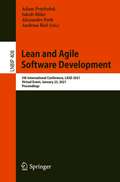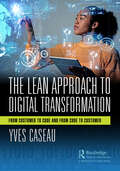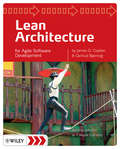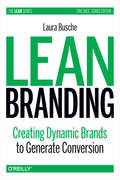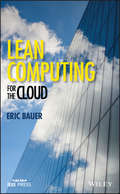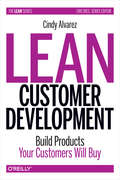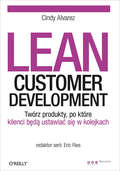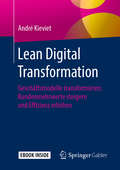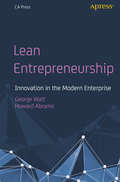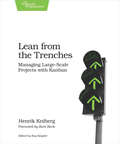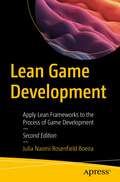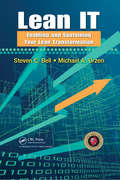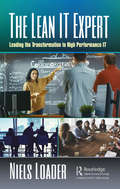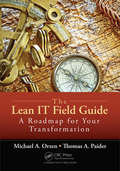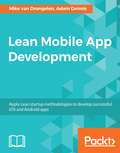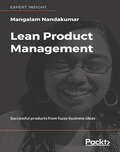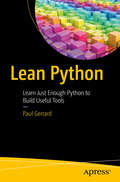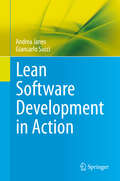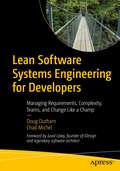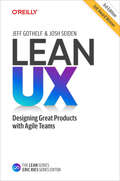- Table View
- List View
Lean and Agile Software Development: 5th International Conference, LASD 2021, Virtual Event, January 23, 2021, Proceedings (Lecture Notes in Business Information Processing #408)
by Adam Przybyłek Jakub Miler Alexander Poth Andreas RielThis book constitutes the proceedings of the 5th International Conference on Lean and Agile Software Development, LASD 2021, which was held online on January 23, 2021. The conference received a total of 32 submissions, of which 10 full and 2 short papers are included in this volume. In addition, one keynote paper is also included. To live the agile mindset, the LASD conference focuses on highly relevant research outcomes and fosters their way into practice. Topics discussed in this volume range from teams under COVID-19 through women in Agile, to product road-mapping and non-functional requirements.
Lean and Green Manufacturing: Towards Eco-Efficiency and Business Performance (Management and Industrial Engineering)
by Kaliyan Mathiyazhagan K. E. K. Vimal Harish Kumar Anbanandam Ramesh Vernika AgarwalThis book provides a stage-by-stage integration of lean and green manufacturing paradigms to achieve environmental and economic benefits. The book includes chapters on conceptual development for incorporating the lean and green paradigm, and methods, tools and techniques for developing and integrating lean manufacturing. Several case studies which demonstrate the benefits of integrating lean and green manufacturing techniques are also covered here. The contents of this book are expected to support researchers and practitioners in the implementation of integrated lean and green manufacturing technologies.
The Lean Approach to Digital Transformation: From Customer to Code and From Code to Customer
by Yves CaseauThe Lean Approach to Digital Transformation: From Customer to Code and From Code to Customer is organized into three parts that expose and develop the three capabilities that are essential for a successful digital transformation: 1. Understanding how to co-create digital services with users, whether they are customers or future customers. This ability combines observation, dialogue, and iterative experimentation. The approach proposed in this book is based on the Lean Startup approach, according to an extended vision that combines Design Thinking and Growth Hacking. Companies must become truly "customer-centric", from observation and listening to co-development. The revolution of the digital age of the 21st century is that customer orientation is more imperative -- the era of abundance, usages rate of change, complexity of experiences, and shift of power towards communities -- are easier, using digital tools and digital communities. 2. Developing an information system (IS) that is the backbone of the digital transformation – called “exponential information system” to designate an open IS (in particular on its borders), capable of interfacing and combining with external services, positioned as a player in software ecosystems and built for processing scalable and dynamic data flows. The exponential information system is constantly changing and it continuously absorbs the best of information processing technology, such as Artificial Intelligence and Machine Learning. 3. Building software “micro-factories” that produce service platforms, which are called “Lean software factories.” This “software factory” concept covers the integration of agile methods, tooling and continuous integration and deployment practices, a customer-oriented product approach, and a platform approach based on modularity, as well as API-based architecture and openness to external stakeholders. This software micro-factory is the foundation that continuously produces and provides constantly evolving services. These three capabilities are not unique or specific to this book, they are linked to other concepts such as agile methods, product development according to lean principles, software production approaches such as CICD (continuous integration and deployment) or DevOps. This book weaves a common frame of reference for all these approaches to derive more value from the digital transformation and to facilitate its implementation. The title of the book refers to the “lean approach to digital transformation” because the two underlying frameworks, Lean Startup and Lean Software Factory, are directly inspired by Lean, in the sense of the Toyota Way. The Lean approach is present from the beginning to the end of this book -- it provides the framework for customer orientation and the love of a job well done, which are the conditions for the success of a digital transformation.
Lean Architecture
by James O. Coplien Gertrud BjørnvigMore and more Agile projects are seeking architectural roots as they struggle with complexity and scale - and they're seeking lightweight ways to do itStill seeking? In this book the authors help you to find your own pathTaking cues from Lean development, they can help steer your project toward practices with longstanding track recordsUp-front architecture? Sure. You can deliver an architecture as code that compiles and that concretely guides development without bogging it down in a mass of documents and guesses about the implementationDocumentation? Even a whiteboard diagram, or a CRC card, is documentation: the goal isn't to avoid documentation, but to document just the right things in just the right amountProcess? This all works within the frameworks of Scrum, XP, and other Agile approaches
Lean Branding: Creating Dynamic Brands to Generate Conversion (Lean (o'reilly) Ser.)
by Laura BuscheEvery day, thousands of passionate developers come up with new startup ideas but lack the branding know-how to make them thrive. If you count yourself among them, Lean Branding is here to help.This practical toolkit helps you build your own robust, dynamic brands that generate conversion. You'll find over 100 DIY branding tactics and inspiring case studies, and step-by-step instructions for building and measuring 25 essential brand strategy ingredients, from logo design to demo-day pitches, using The Lean Startup methodology's Build-Measure-Learn loop.Learn exactly what a brand is--and what it isn'tBuild a minimal set of brand ingredients that are viable in the marketplace: brand story, brand symbols, and brand strategyMeasure your brand ingredients by using meaningful metrics to see if they meet your conversion goalsPivot your brand ingredients in new directions based on what you've learned--by optimizing rather than trashingFocus specifically on brand story, symbols, or strategy by following the Build-Measure-Learn chapters that apply
Lean Computing for the Cloud
by Eric BauerApplies lean manufacturing principles across the cloud service delivery chain to enable application and infrastructure service providers to sustainably achieve the shortest lead time, best quality, and value <p><p> Applies lean thinking across the cloud service delivery chain to recognize and minimize waste <p> Leverages lessons learned from electric power industry operations to operations of cloud infrastructure <p> Applies insights from just-in-time inventory management to operation of cloud based applications <p> Explains how traditional, Information Technology Infrastructure Library (ITIL) and Enhanced Telecom Operation Map (eTOM) capacity management evolves to lean computing for the cloud
Lean Customer Development
by Cindy AlvarezHow do you develop products that people will actually use and buy? This practical guide shows you how to validate product and company ideas through customer development research--before you waste months and millions on a product or service that no one needs or wants.With a combination of open-ended interviewing and fast and flexible research techniques, you'll learn how your prospective customers behave, the problems they need to solve, and what frustrates and delights them. These insights may shake your assumptions, but they'll help you reach the "ah-ha!" moments that inspire truly great products.Validate or invalidate your hypothesis by talking to the right peopleLearn how to conduct successful customer interviews play-by-playDetect a customer's behaviors, pain points, and constraintsTurn interview insights into Minimum Viable Products to validate what customers will use and buyAdapt customer development strategies for large companies, conservative industries, and existing products
Lean Customer Development: Building Products Your Customers Will Buy
by Cindy AlvarezHow do you develop products that people will actually use and buy? This practical guide shows you how to validate product and company ideas through customer development research—before you waste months and millions on a product or service that no one needs or wants.With a combination of open-ended interviewing and fast and flexible research techniques, you’ll learn how your prospective customers behave, the problems they need to solve, and what frustrates and delights them. These insights may shake your assumptions, but they’ll help you reach the "ah-ha!" moments that inspire truly great products.Validate or invalidate your hypothesis by talking to the right peopleLearn how to conduct successful customer interviews play-by-playDetect a customer’s behaviors, pain points, and constraintsTurn interview insights into Minimum Viable Products to validate what customers will use and buyAdapt customer development strategies for large companies, conservative industries, and existing products
Lean Customer Development.
by Cindy AlvarezZnaj klienta swego Zweryfikuj swoj? hipotez?, rozmawiaj?c z w?a?ciwymi osobami. Krok po kroku naucz si? prowadzi? skuteczne wywiady Customer Development. Rozpoznawaj zachowania klientów, ich problemy i ograniczenia. Na podstawie pozyskanych w ten sposób informacji zbuduj minimalnie satysfakcjonuj?cy produkt, który pozwoli Ci potwierdzi?, co klienci s? sk?onni kupi? i czego b?d? u?ywa?. Dostosuj techniki sk?adaj?ce si? na model Customer Development do potrzeb du?ych organizacji, konserwatywnych bran? i istniej?cych ju? produktów.Jak tworzy? produkty, które ludzie b?d? chcieli kupowa?? Bez wzgl?du na to, czy jeste? w?a?cicielem niewielkiej firmy czy pracownikiem wielkiego koncernu, zadajesz sobie to samo pytanie. Je?li szukasz niezawodnej metody badania potrzeb i preferencji klientów, dzi?ki której zaoszcz?dzisz wiele miesi?cy pracy oraz mnóstwo pieni?dzy, zapraszamy do ?wiata Lean Customer Development.To metoda id?ca o krok dalej ni? tradycyjne techniki marketingowe. Nie tylko pomo?e Ci pozna? potrzeby i preferencje klientów oraz zg??bi? user experience, ale zweryfikuje t? wiedz? na drodze eksperymentów naukowych. Dzi?ki odpowiedniemu po??czeniu otwartych wywiadów oraz szybkich i elastycznych technik badawczych dowiesz si?, jak zachowuj? si? Twoi potencjalni klienci, jakie problemy usi?uj? rozwi?za?, a tak?e co ich frustruje, a co jest przedmiotem ich zachwytów. Dowiedz si?, jak zmienia? zachowania konsumentów, tworzy? wielkie produkty i budowa? trwa?? firm?.Ksi??ki z serii Lean, serii, której redaktorem jest http://helion.pl/autorzy/eric-ries,eriris.htm">Eric Ries, za?o?yciel ruchu Lean Startup. Niniejsza ksi??ka k?adzie nacisk na podstawowe aspekty metodologiczne i zawiera praktyczne przyk?ady, opracowane z my?l? o deweloperach, mened?erach i innych cz?onkach zespo?u Twojego startupu. Dzi?ki niej poznasz skuteczne narz?dzia i przyjmiesz sposób my?lenia sprzyjaj?cy podejmowaniu szybkich i m?drych decyzji.
Lean Digital Transformation: Geschäftsmodelle transformieren, Kundenmehrwerte steigern und Effizienz erhöhen
by André KievietLernen Sie mit diesem Buch, wie Sie Prozesse der Lean Digital Transformation erfolgreich umsetzenMit seinem Buch „Lean Digital Transformation“ zeigt André Kieviet, dass die Umsetzung digitaler Strukturen innerhalb größerer Organisationen keine unlösbare Aufgabe ist. Finden Sie heraus, wie Sie die Möglichkeiten der Digitalisierung für Unternehmen nutzen können. Ein situatives Ordnungsschema unterstützt Sie bei der Frage nach relevanten, technologischen Werkzeugen.Methodisches Wissen und Praxisempfehlungen stehen im FokusZunächst beantwortet der Autor die grundlegenden Fragen „Was ist Digitalisierung und warum gibt es gerade jetzt diesen Hype?“. Auf diese Weise wird Ihnen dieses Konzept verständlich erläutert. Anschließend widmet sich Kieviet dem pragmatischen Ansatz der Lean Digital Transformation. Der Begriff „Lean“ wurde von ihm bewusst gewählt und beleuchtet zwei Perspektiven:Lean steht für Einfachheit: Firmen sollten nicht digitalisieren, nur um sich einem aktuellen Trend unterzuordnen. Vielmehr geht es um die zielorientierte Nutzung von Informationen mit maschineller Hilfe.Lean steht für das Konzept des Lean Managements: Durch den absoluten Fokus auf den Kundenmehrwert soll jegliche Form der Verschwendung im Rahmen des digitalen Umbruchs reduziert werden.André Kieviet führt diese beiden Dimensionen zusammen. Durch diesen pragmatischen, sowie anhand von Beratungsprojekten entwickelten Ansatz, eignen Sie sich nicht nur neues, methodisches Wissen an. Gleichzeitig dient Ihnen dieses Werk als Praxisleitfaden, mit dem Sie neue Anwendungsfelder der Digitalisierung sowie anwendbare Technologien für Ihr Unternehmen entdecken. Auf diese Weise sind Sie in der Lage, die digitalen Transformationsprozesse von Geschäftsmodellen, Unternehmenskultur oder der Mitarbeiterkommunikation selbst zu meistern – ideal für Praktiker, Unternehmer sowie Berater.
Lean Entrepreneurship: Innovation In The Modern Enterprise
by George Watt Howard AbramsUtilize this comprehensive guide in your organization to create a corporate incubator that protects innovative ideas from oppressive corporate processes and culture and gives those ideas the resources and environment they need to grow and have the best possible chance to thrive. Innovation is hard. Ironically, innovation in a large enterprise can be even more difficult. Policies designed for mature businesses often crush emerging businesses along with the entrepreneurial spirit of the innovators. Procedures can make it difficult, even impossible, for innovative employees to get their ideas funded, or even seen. As a result, even companies with their roots in innovation can find themselves unable to innovate, with a devastating impact on employee morale and often resulting in the exodus of the most creative employees. In Lean Intrapreneurship the authors leverage decades of personal experience innovating in large enterprises to explore the root causes of failure to innovate in established organizations, and offer a solution to the innovator’s dilemma. The book includes a recipe for creating a repeatable program for innovating in large organizations, including tools, tips, and strategies developed by the authors as they created an innovative incubation program for a multi-billion-dollar technology company. It also offers a wealth of information to help aspiring intrapreneurs and entrepreneurs bring their ideas to life. What You’ll LearnDiscover the most common reasons that innovation fails in established organizationsExplore techniques to make innovative ideas a successFollow a recipe to create a program to enable innovation across your companyUnderstand the power of transparency inside and outside an incubatorDevelop employees and foster a culture of innovation across your company Who This Book Is For Anyone with an innovative idea who wants to make it real but does not know where to begin; anyone struggling to innovate inside an established company; anyone who wishes to make their existing company more lean, agile, and efficient; anyone who wishes to start a program to incubate new, innovative ideas inside an established company
Lean from the Trenches: Managing Large-Scale Projects with Kanban
by Henrik KnibergYou know the Agile and Lean development buzzwords, you've read the books. But when systems need a serious overhaul, you need to see how it works in real life, with real situations and people. Lean from the Trenches is all about actual practice. Every key point is illustrated with a photo or diagram, and anecdotes bring you inside the project as you discover why and how one organization modernized its workplace in record time.Lean from the Trenches is all about actual practice.Find out how the Swedish police combined XP, Scrum, and Kanban in a 60-person project. From start to finish, you'll see how to deliver a successful product using Lean principles. We start with an organization in desperate need of a new way of doing things and finish with a group of sixty, all working in sync to develop a scalable, complex system. You'll walk through the project step by step, from customer engagement, to the daily "cocktail party," version control, bug tracking, and release. In this honest look at what works--and what doesn't--you'll find out how to:Make quality everyone's business, not just the testers.Keep everyone moving in the same direction without micromanagement.Use simple and powerful metrics to aid in planning and process improvement.Balance between low-level feature focus and high-level system focus.You'll be ready to jump into the trenches and streamline your own development process.
Lean Game Development: Apply Lean Frameworks to the Process of Game Development
by Julia Naomi Rosenfield BoeiraMaster Lean UX and Lean Startup techniques to improve your agile game development experience beyond Scrum. This updated version of the book focuses on applying lean and agile methodologies to the game development process and features improved examples, applied techniques, and a whole new section explaining how to test a game in Unity with CI. You'll see how to define a minimum viable product (MVP) for games with Lean Canvas, allowing customers to iterate over it and collect feedback for improvement at every cycle. All of these are achieved while still using standard Agile techniques. The first part of the book explains the ideation process of a game and how lean methodologies allow developers, especially small studios, to avoid scope creep. Next, it it provides guidance on creating MVPs and using player feedback to iterate and improve games. The book then discusses continual improvement (CI) methods. A crucial part of CI is generation of Lean Canvas. Lean Game Development, Second Edition shows you how to iterate until you develop a game that satisfies developers, gamers, and your studio's financial goals.What You'll LearnStudy lean and agile methodologies to enhance the game development process Find out how to improve the way game productions define value and iterate over itApply development strategies to enrich the game development processWho This Book Is ForPeople from all sectors of the gaming industry will find the book useful in planning their project in a more iterative way, unloading the management burden on the development process and collecting feedback to improve the game content as early as possible.
Lean, Green and Sustainability: 8th IFIP WG 5.7 European Lean Educator Conference, ELEC 2022, Galway, Ireland, November 22–24, 2022, Proceedings (IFIP Advances in Information and Communication Technology #668)
by Olivia McDermott Angelo Rosa José Carlos Sá Aidan TonerThis book constitutes the refereed proceedings of the 8th European Lean Educator Conference ELEC 2022, which took place in Galway, Ireland, in November 2022; the event was sponsored by IFIP WG 5.7. The 28 full papers presented were carefully reviewed and selected for inclusion in the proceedings. They are organized in the following thematic sections: Lean & People; Lean in Healthcare; Lean 4.0; Lean in Manufacturing; Lean Learning in the Digital Era; Lean, Green & Sustainability; and Lean in Services.
Lean IT: Enabling and Sustaining Your Lean Transformation
by Steven C Bell Michael A OrzenWinner of a Shingo Research and Professional Publication AwardInformation Technology is supposed to enable business performance and innovation, improve service levels, manage change, and maintain quality and stability, all while steadily reducing operating costs. Yet when an enterprise begins a Lean transformation, too often the IT department is ei
The Lean IT Expert: Leading the Transformation to High Performance IT
by Niels LoaderDigital transformation is a business concern; it is no longer just IT that must get things done. The disruptive force of start-ups focusing on IT-based services that can be consumed through mobile devices cannot be underestimated -- These start-ups eat away at the high-margin services provided by incumbents, leaving lower margin products and services that are rapidly being commoditized. This is happening in all industry sectors and it is the ones who are best able to adjust, innovate, and improve their service offerings that will survive. The question is: What do you need to do to ensure that your organization is one of the survivors? The core of the solution to the problem is to radically improve the way the IT organization works together with the business. To be clear, the digital transformation of your business depends on that relatively small group of people in the basement, or other out-of-the-way location, who make sure that your IT services work. So, building a cooperative model is vital for the success of the business. Which model has proven its worth in many industries? It is the application of Lean principles that gives organizations an advantage in delivering their products and services to their customers. Transforming your organization to high performance is, above all, a people-based movement with the acquisition and, most importantly, application of knowledge and skills necessary for the high performance way of working at its core. In teams, from boardroom to work floor, building a new way of thinking and acting is essential. This book aims to give insight into the reasons why you and your organization must consciously act to apply Lean principles to your IT organization. It explains the phases organizations go through as they start out with their initial attempts to gain advantages from Lean tools to the phase in which they reap the strategic benefits of Lean applied to IT. The real work of the transformation is described from two different perspectives: Leadership and Team. This book describes a complete set of principles, practices and tools In order to make the right decisions along the winding route of your transformation. The people who will guide, support and drive your transformation are the leaders and tem members who understand and apply those principles, practice and tools: your Lean IT Experts.
The Lean IT Field Guide: A Roadmap for Your Transformation
by Michael A. Orzen Thomas A. PaiderHow many IT books have you read that are long on theory and short on practical application? They are interesting, but not very impactful. They provide a framework from which to think and understand, but lack a process from which to act. Addressing this urgent need for the IT community, The Lean IT Field Guide explains how to initiate, execute, and sustain a lean IT transformation.Illuminating a clear path to lean IT, the authors integrate more than two decades of combined experience to provide you with a proven method for creating and sustaining a true lean IT workplace. This field guide not only highlights the organizational techniques of more agile and lean processes, but also the leadership work required to help management adopt these new approaches.Based on proven methods from different industries, including banking, manufacturing, insurance, food and beverage, and logistics, the book details a clear model that covers all the components you need to achieve and sustain a favorable work environment and culture in support of lean IT.Filled with anecdotes and case studies from actual businesses, the book includes pictures, templates, and examples that illustrate the application of the lean methods discussed.
The Lean IT Field Guide: A Roadmap for Your Transformation
by Michael A. Orzen Thomas A. PaiderHow many IT books have you read that are long on theory and short on practical application? They are interesting, but not very impactful. They provide a framework from which to think and understand, but lack a process from which to act. Addressing this urgent need for the IT community, The Lean IT Field Guide explains how to initiate, execute, and sustain a lean IT transformation.Illuminating a clear path to lean IT, the authors integrate more than two decades of combined experience to provide you with a proven method for creating and sustaining a true lean IT workplace. This field guide not only highlights the organizational techniques of more agile and lean processes, but also the leadership work required to help management adopt these new approaches.Based on proven methods from different industries, including banking, manufacturing, insurance, food and beverage, and logistics, the book details a clear model that covers all the components you need to achieve and sustain a favorable work environment and culture in support of lean IT.Filled with anecdotes and case studies from actual businesses, the book includes pictures, templates, and examples that illustrate the application of the lean methods discussed.
Lean Mobile App Development
by Alberto Gonzalez Mike Van Drongelen Adam Dennis Richard Garabedian Aravind KrishnaswamyDevelop lean iOS and Android apps using industry standard techniques and lean development practices. About This Book • Build ready-to-deploy apps with less iterations and shorter development times • Adopt the lean startup methodologies to develop iOS and Android apps that shine in the App Store • This hands-on guide puts continuous innovation into practice to develop successful mobile apps Who This Book Is For This book is for developers, CTOs, and architects working for a startup or another kind of lean startup environment, such as start-up within a cooperation. It is is ideal for any iOS and Android developer who wants to build successful mobile apps by adopting the lean startup methodology. What You Will Learn • Apply the lean startup methodology to real Android and iOS development • Define what your hypotheses are by creating an Minimal Viable Product • Validate your idea against the Business Model Canvas • Gather feedback through statistics and by getting user comments, learn from it, and adapt your app accordingly • Develop skills and devise strategies to build versatile and flexible apps that meet changing business requirements • Investigate the possibilities when you need to pivot your start-up idea whether in a startup or an established business. • Create a successful app and get tips on how to boostconversion and how to optimize the on boardingprocess. In Detail Lean is the ultimate methodology for creating a startup that succeeds. Sounds great from a theoretical point of view, but what does that mean for you as an a technical co-founder or mobile developer? By applying the Lean Start-up methodology to your mobile App development, it will become so much easier to build apps that take Google Play or the App Store by storm. This book shows you how to bring together smarter business processes with technical know-how. It makes no sense to develop a brilliant app for six months or longer only to find out later that nobody is interested in it. Build a Minimum Viable Product (MVP) first. Validate your hypotheses early and often. Discover effective product development strategies that let you put Facebook's famous axiom "move fast and break things" into practice. A great app without visibility and marketing clout is nothing, so use this book to market your app, making use of effective metrics that help you track and iterate all aspects of project performance. Style and approach This book takes a hands-on approach to developing apps through the Lean Start-up Methodology. Following a 50% business and 50% tech approach, this book is filled with practical examples and real-world experiments.
Lean Out: The Struggle For Gender Equality In Tech And Start-up Culture
by Elissa ShevinskyWhy aren't the great, qualified women already in tech being hired or promoted? Should people who don't fit in seek to join an institution that is actively hostile to them? Does the tech industry deserve women leaders? The split between the stated ideals of the corporate elite and the reality of working life for women in the tech industry--whether in large public tech companies or VC-backed start-ups, in anonymous gaming forums, or in Silicon Valley or Alley--seems designed to crush women's spirits. Corporate manifestos by women who already fit in (or who are able to convincingly fake it) aren't helping. There is a high cost for the generation of young women and transgender people currently navigating the harsh realities of the tech industry, who gave themselves to their careers only to be ignored, harassed and disrespected. Not everyone can be a CEO; not everyone is able to embrace a workplace culture that diminishes the contributions of women and ignores real complaints. The very culture of high tech, where foosball tables and endless supplies of beer are de facto perks, but maternity leave and breast-feeding stations are controversial, is designed to appeal to young men. Lean Out collects 25 stories from the modern tech industry, from people who fought GamerGate and from women and transgender artists who have made their own games, from women who have started their own companies and who have worked for some of the most successful corporations in America, from LGBTQ women, from women of color, from transgender people and people who do not ascribe to a gender. All are fed up with the glacial pace of cultural change in America's tech industry. Included are essays by anna anthropy, Leigh Alexander, Sunny Allen, Lauren Bacon, Katherine Cross, Dom DeGuzman, FAKEGRIMLOCK, Krys Freeman, Gesche Haas, Ash Huang, Erica Joy, Jenni Lee, Katy Levinson, Melanie Moore, Leanne Pittsford, Brook Shelley, Elissa Shevinsky, Erica Swallow, and Squinky. Edited and selected by entrepreneur and tech veteran Elissa Shevinsky, Lean Out sees a possible way forward that uses tech and creative disengagement to jettison 20th century corporate culture: ''I've figured out a way to create safe space for myself in tech,'' writes Shevinsky. ''I've left Silicon Valley, and now work remotely from home. I adore everyone on my team, because I hired them myself.
Lean Product Management: Successful products from fuzzy business ideas
by Mangalam NandakumarA guide to product management exploring the best practices: identifying the impact-driven product, planning for success, setting up and measuring time-bound metrics, and developing a lean product roadmap.Key FeaturesIdentifying Impact-Driven ProductsInvesting in Key Business OutcomesValue mapping to maintain a lean product backlogUtilizing time-bound product metricsEliminating process wasteBook DescriptionLean Product Management is about finding the smartest way to build an Impact Driven Product that can deliver value to customers and meet business outcomes when operating under internal and external constraints. Author, Mangalam Nandakumar, is a product management expert, with over 17 years of experience in the field. Businesses today are competing to innovate. Cost is no longer the constraint, execution is. It is essential for any business to harness whatever competitive advantage they can, and it is absolutely vital to deliver the best customer experience possible. The opportunities for creating impact are there, but product managers have to improvise on their strategy every day in order to capitalize on them. This is the Agile battleground, where you need to stay Lean and be able to respond to abstract feedback from an ever shifting market. This is where Lean Product Management will help you thrive. Lean Product Management is an essential guide for product managers, and to anyone embarking on a new product development. Mangalam Nandakumar will help you to align your product strategy with business outcomes and customer impact. She introduces the concept of investing in Key Business Outcomes as part of the product strategy in order to provide an objective metric about which product idea and strategy to pursue. You will learn how to create impactful end-to-end product experiences by engaging stakeholders and reacting to external feedback. What you will learnHow do you execute ideas that matter?How can you define the right success metrics?How can you plan for product success?How do you capture qualitative and quantitative insights about the product? How do you know whether your product aligns to desired business goals?What processes are slowing you down?Who this book is forIf you are leading a team that is building a new product, then this book is for you. The book is targeted at product managers, functional leads in enterprises, business sponsors venturing into new product offerings, product development teams, and start-up founders.
Lean Python
by Paul GerrardLearn only the essential aspects of Python without cluttering up your mind with features you may never use. This compact book is not a "best way to write code" type of book; rather, the author goes over his most-used functions, which are all you need to know as a beginner and some way beyond. Lean Python takes 58 Python methods and functions and whittles them down to 15: as author Paul Gerrard says, "I haven't found a need for the rest. " What You'll Learn Discover lean Python and how to learn just enough to build useful tools Use Python objects, program structure, I/O, modules and more Handle errors and exceptions Test your code Access the Web; do searching; and persist data Who This Book Is For This book is aimed at three categories of reader: The experienced programmer - if you already know a programming language, this book gives you a shortcut to understanding the Python language and some of its design philosophy. You work in IT and need a programming primer - you might be a tester who needs to have more informed technical discussions with programmers. Working through the examples will help you to appreciate the challenge of good programming. First-timer - you want a first book on programming that you can assimilate quickly to help you decide whether programming is for you.
Lean Software Development in Action
by Andrea Janes Giancarlo SucciThis book illustrates how goal-oriented, automated measurement can be used to create Lean organizations and to facilitate the development of Lean software, while also demonstrating the practical implementation of Lean software development by combining tried and trusted tools. In order to be successful, a Lean orientation of software development has to go hand in hand with a company's overall business strategy. To achieve this, two interrelated aspects require special attention: measurement and experience management. In this book, Janes and Succi provide the necessary knowledge to establish "Lean software company thinking," while also exploiting the latest approaches to software measurement. A comprehensive, company-wide measurement approach is exactly what companies need in order to align their activities to the demands of their stakeholders, to their business strategy, etc. With the automatic, non-invasive measurement approach proposed in this book, even small and medium-sized enterprises that do not have the resources to introduce heavyweight processes will be able to make their software development processes considerably more Lean. The book is divided into three parts. Part I, "Motivation for Lean Software Development," explains just what "Lean Production" means, why it can be advantageous to apply Lean concepts to software engineering, and which existing approaches are best suited to achieving this. Part II, "The Pillars of Lean Software Development," presents the tools needed to achieve Lean software development: Non-invasive Measurement, the Goal Question Metric approach, and the Experience Factory. Finally, Part III, "Lean Software Development in Action," shows how different tools can be combined to enable Lean Thinking in software development. The book primarily addresses the needs of all those working in the field of software engineering who want to understand how to establish an efficient and effective software development process. This group includes developers, managers, and students pursuing an M. Sc. degree in software engineering.
Lean Software Systems Engineering for Developers: Managing Requirements, Complexity, Teams, and Change Like a Champ
by Doug Durham Chad MichelGraduate to the next level of your software development career, learning the tools you need to successfully manage the complexity of modern software systems.Whether you are a developer at a small software company, or one of many developers at a large enterprise, your success directly correlates to the ability of your development team to rapidly respond to change. What makes this task challenging in today’s world, is that the technical challenges we as developers strive to overcome are becoming increasingly more complex. We have to consider many more options when it comes to things like requirements, solution hosting, support, pace of change, and generally with less time and warning.A good developer knows that it is critical to manage every aspect of software development from soup to nuts, and understands that when details and decisions are left to chance, outcomes can be negatively impacted. Poor planning can result in increased errors, substandard quality, budget and schedule overruns, and result in the ultimate business failure, dissatisfied customers, and stakeholders.This book will help you put on the lenses of a software engineer. You will come away with an understanding of how to view the entire spectrum of the software development process, learn valuable concepts, and apply these principles through meaningful examples, case studies, and source code. What You Will LearnMove beyond being a programmer to being a professional software engineerSpend more time doing software development; minimize time spent dealing with ineffective or inadequate processesReduce errors in judgment and provide predictable outcomes, while still maintaining agility and responsiveness using Lean and Agile practicesKnow the steps you can take to ensure a shared understanding among stakeholdersDiscover tools to validate user experience early and often to minimize costly re-workDevelop software designs and architectures that enable long-term business agilityImplement patterns and processes that result in “falling into the pit of success” instead of into the “pit of failure”Adopt processes and patterns that will result in pervasive “institutionalized” qualityUnderstand the necessity of redefining the essential role of technical leadership to ensure team maturity and growth Who This Book Is ForSoftware developers and team leaders who have struggled to implement design and development best practices due to lack of team resources, in-depth knowledge, or experience, and want a book designed to provide the confidence and foundational skills needed to achieve success
Lean UX
by Jeff Gothelf Josh SeidenLean UX is synonymous with modern product design and development. By combining human-centric design, agile ways of working, and a strong business sense, designers, product managers, developers, and scrum masters around the world are making Lean UX the leading approach for digital product teams today.In the third edition of this award-winning book, authors Jeff Gothelf and Josh Seiden help you focus on the product experience rather than deliverables. You'll learn tactics for integrating user experience design, product discovery, agile methods, and product management. And you'll discover how to drive your design in short, iterative cycles to assess what works best for businesses and users. Lean UX guides you through this change--for the better.Facilitate the Lean UX process with your team with the Lean UX CanvasEnsure every project starts with clear customer-centric success criteriaUnderstand the role of designer on a agile teamWrite and contribute design and experiment stories to the backlogEnsure that design work takes place in every sprintBuild product discovery into your team's "velocity"
